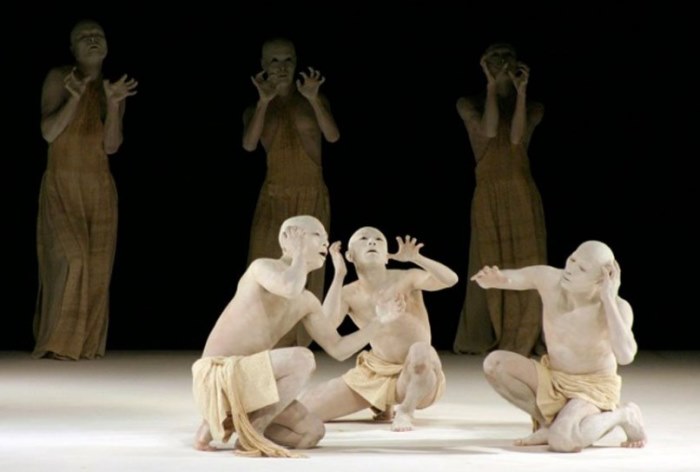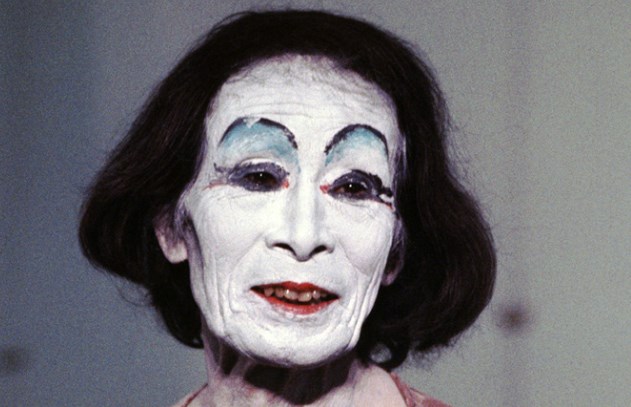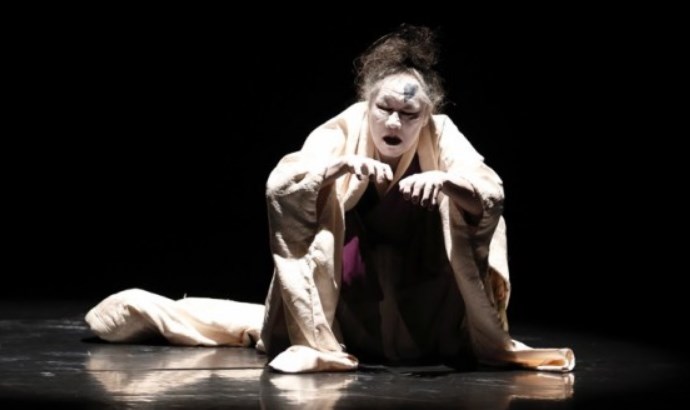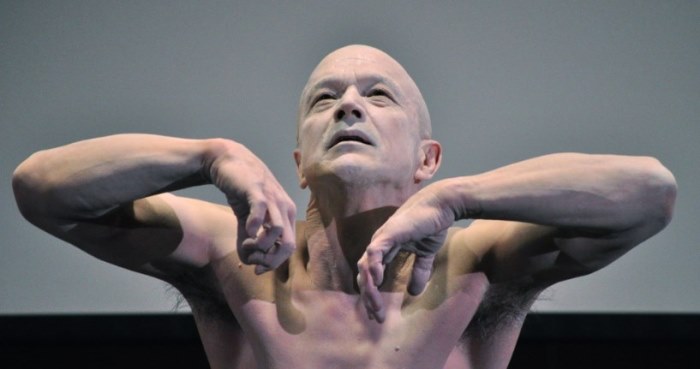Exploring Japanese culture would not be complete without delving into the world of Butoh dance, also known as the “Dance of Darkness.” This avant-garde dance form is a staple of Japanese culture in the chaotic post-war period in the 1950s.
This article will give you an overview of the Butoh dance history (including why it’s called the “Dance of Darkness”). As a bonus, you’ll also learn about the dance’s key characteristics and the names of the most renowned artists in this dance genre!
Table of Contents
What Is Butoh?
The word “Butoh” is a compound word formed from two Kanji characters (舞踏), meaning “Dance” and “Step.” But this isn’t the full name of the dance. Originally, it was called “ankoku butoh” (暗黒舞踏), which means “Dance of Darkness.”
Butoh dance meaning is so-called the “Dance of Darkness” because of the dark and distorted theme of the dance. Some critics even use some pretty extreme words to describe it, including “deviant” and “grotesque”.
Butoh Dance History
Early History
The Butoh dance came to being in the late 1950s and early 1960s as the brainchild of the legendary Japanese choreographer, Tatsumi Hijikata, and dancer Kazuo Ohno.
The purpose of Butoh dance is to be a reaction to the theater industry in Japan at the time, which was being increasingly westernized.
During an interview, Hijikata stated that he wanted to “turn away from the Western styles of dance, ballet and modern” with Butoh and return instead to an aesthetic that he deemed to be: “the natural movements of the common folk.”
And indeed, the ankoku butoh dance that he eventually created was nothing like the light, airy, and graceful dances from the west like ballet. Instead, the choreography is filled with “crude physical gestures and uncouth habits”.
Hijikata himself probably put it best: “the butoh dance is meant to be an assault on the refinement (Miyabi) and understatement (Shibui) so valued in Japanese aesthetics.”
The first butoh piece, called “Forbidden Colors” (禁色), is about the marriage of a gay man to a woman. Homosexuality was extremely taboo in Japanese society at the time, butoh dove into it head first and explored the theme in graphic detail on stage.
How graphic, you ask?
The piece ended with a live chicken being squeezed to death between the thigh of the actor.
The audience at the time didn’t take too well to this, and the backlash against Hijikata was massive. The festival that hosted the piece’s premiere banned Hijikata from further participating.
Rise and the Renaissance
That, fortunately, wasn’t the end of butoh.
Thanks to Kazuo Ohno and the persistence of Hijikata, butoh not only didn’t fade away as a fickle shock art, but it thrived. The pair further developed dance techniques and taught them to some students, who created their dance troupes and performed across Japan.
In the 80s, butoh experienced a “renaissance” when butoh dance groups began to export this exotic dance form abroad. The most well-known butoh group in North America is Sankai Juku, which is still active and touring today.
If you’re wondering how and why Butoh dance is popular in the US… then it’s all due to a tragedy.
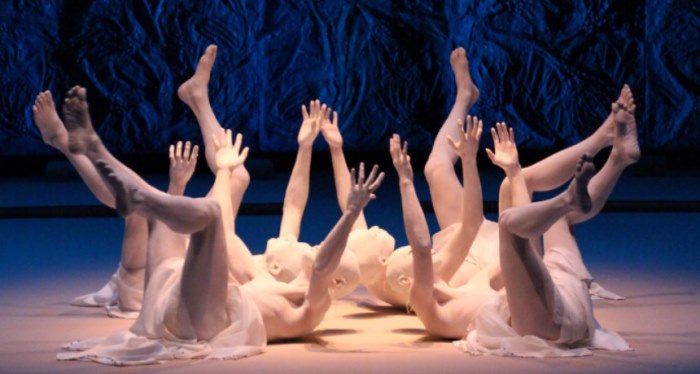
The dance’s popularity is partly attributed to an accident that got onto national television. During a daring butoh performance by the Sankai Juku in Seattle, Washington, in which the performers acted out the piece while hanging upside down from ropes hanging from a building, one of the ropes broke, resulting in the death of one performer.
It’s not the only time that butoh was introduced to North American TV viewers. A PBS documentary was aired during this period of a butoh performance in a cave. This further popularized the exotic Japanese art form to western audiences.
Controversies on the Butoh’s founder
Butoh wasn’t without its internal controversies. There are still a lot of arguments surrounding who should be the one to be credited with the invention of butoh. Most pointed to Hijikata, but there are many other artists that claimed to have created the “butoh” art, like Iwana Masaki (岩名雅紀) and Min Tanaka (田中民).
But after all, that’s said and done. Most dance historians and pundits still agree that Hijikata was the founder of butoh.
Japanese Butoh Dance Characteristics
Butoh is best known for being against every convention and custom that’s held dear in Japanese artistic standards, from the theme of the pieces to the costumes and the choreographies.
Although butoh performances and choreographies will differ depending on the dancer and choreographer at the helm, you’ll see some shared characteristics between them.
Slow, Controlled, and Intense Movements
This part sets butoh apart from traditional Western dance forms like ballet. Instead of moving quickly and gracefully, butoh performers (called “butoh-ka”) move in a very slow and controlled manner.
At times, they limp like the dead. The performers’ movements on stage can be very disturbing for first-time viewers.
But once you get over it, you’ll find that the slow movements are on purpose.
Combined with the white body paint and exaggerated facial expressions, the slower movements allow you to take in the pure emotions being expressed by the butoh-ka, which is often a confounding mixture of joy and anguish.
White Body Paint and Shaved Heads
Butoh-ka may spend hours before each show doing their makeup. On stage, they’re decked out in full white body paint, which is meant to represent a “childlike purity” for the dancers.
The performer’s painting and nakedness strip away any preconceptions the audience may have about the dancer.
Improvisation
Hijikata was well-known for discouraging any attempt to codify his work and was quoted as saying: “Since I believe neither in a dance teaching method nor in controlling movement, I do not teach in this manner.”
In butoh, the performer is expected to improvise rather than try to memorize and execute a specific set of choreography and moves. This is one of the greatest differences between butoh and Western dances. In ballet, for example, the ballerina is expected to rehearse every sequence until it becomes almost second nature.
However, in butoh, the touch, feel, and capture of a specific mood is far more important. The butoh-ka is let loose to use any means and any move necessary to these ends.
That’s why no butoh performance looks quite the same as the other, even if they’re playing the same piece!
Famous Butoh Dancers
Through the years, there have been generations of butoh dancers. But none have surpassed the level of fame and artistic quality of these dancers.
Kazuo Ohno – The most famous of all Butoh dancers
Alongside Tatsumi Hijikata, Kazuo Ohno is often cited as one of the minds behind what’s now known as the Ohno dance.
Born in Hakodate City, Hokkaido on October 27th, 1906, Kazuo displayed a talent for athletics at an early age. His path to becoming a dancer started in 1933 when he was tutored by Baku Ishii and Takaya Eguchi, both of whom are modern dance pioneers and gurus.
In 1938, Kazuo Ohno was drafted into the Japanese Army. He was captured by the Australians as a prisoner of war (POW) during combat in New Guinea.
Ohno’s experiences during the war were a significant source of inspiration for many of his later performances, including the Jellyfish Dance. It is said that this particular dance was inspired by the burials at sea that he witnessed on the transport ship back to Japan after the war had ended.
In the 60s, together with Tatsumi Hijikata, developed a set of dance movements and ideas that he later called “Ankoku Butoh-ha” – the “Dance of Darkness”.
In the next few decades, Ohno developed a number of great butoh works that are still being performed today, such as “My Mother”, “Dead Sea”, and “Water Lilies”.
Ohno dedicated almost the entirety of his life to dancing. In 2001, even after he lost the ability to walk, Ohno still performed on stage by moving his hands.
He passed away in 2010 from respiratory failure at the age of 103.
Tadashi Endo
Tadashi Endo, born in 1947, is a renowned butoh dancer and choreographer known for bringing the art of butoh to Europe.
He is considered to be one of the most well-known butoh dancers of today. Little is known about Endo’s early life, but prior to founding the MAMU butoh center in Göttingen, Germany, he toured across the continent as a solo dancer, accompanied by jazz bands.
In 1988, Endo met Kazuo Ohno, who introduced him to the art of butoh and inspired him to pursue it.
Endo’s butoh performances are often described as “stark” and are heavily influenced by Ohno’s dance style, with an added twist of being usually accompanied by live or recorded jazz music. According to Endo, the chaotic and improvisational sound of jazz has a “natural affinity” with butoh.
Endo’s butoh dance center is still active today, training new students on the art of butoh, as well as hosting dance festivals at the Goettingen Junges Theater annually.
Jay Hirabayashi
Jay Hirabayashi is a Canadian-Japanese butoh dancer, choreographer, and teacher. He is considered one of the leading figures in the Butoh dance style in North America.
He began his dance training in the early 1970s, studying contemporary dance and ballet. But soon afterward, Hirabayashi discovered butoh dance through a presentation by the Harupin-ha Butoh dance company, led by butoh masters Koichi and Hiroko Tamano.
Hirabayashi was immediately drawn to its unique style and themes. During an interview, he was quoted as saying: “… we have never forgotten that performance […] Tamano’s solo took our breath away and stopped time.”
Inspired by what he saw during the presentation, Hirayabashi traveled to Japan to study with some of the leading Butoh dancers and choreographers, including Kazuo Ohno.
Hirabayashi’s performances are known for their intense physicality and emotional depth. He often incorporates elements of Japanese traditional dance, such as Kabuki and Noh, into his Butoh choreography.
Outside of tours and performances, Hirabayashi is a butoh teacher, giving classes in many countries including Japan, Europe, and North America.
He is the founder of the Kokoro Dance Company in Toronto.
Famous Butoh Dance Performances
Forbidden Colors (1959)
“Forbidden Colors” is a butoh dance piece created and performed by Japanese dancer and choreographer Kazuo Ohno. It’s adapted from a Japanese novel of the same name by Yukio Mishima.
The piece was first performed in 1983 and is considered one of Ohno’s most iconic works. It’s also the first piece to appear in the butoh repertoire.
“Forbidden Colors” is a piece that explores themes of love, desire, and the human condition. The title “Forbidden Colors” refers to the taboo nature of love and desire in traditional Japanese culture.
This piece is known for its slow, fluid movements and the infamous use of unconventional, even grotesque, imagery to convey its message. The piece famously (or infamously) ended with a live chicken being held between the legs of Yoshito Ohno (Kazuo Ohno’s son). After which, Hijikata chased Yoshito off the stage and into the darkness.
The shock value was immense when the piece first premiered at a festival. The public was so disturbed by what they saw that Hijikata (the director behind the piece) was further banned from participating in the festival.
“Forbidden Colors” is considered a masterpiece in the world of butoh dance. But it has value outside of butoh, too. And, it is widely regarded as an important piece in the history of contemporary dance.
My Mother (1998)
“My Mother” is a butoh work written and debuted by Kazuo Ohno.
The piece was first performed in 1990. While “Forbidden Colors” was considered to be Ohno’s most significant work, “My Mother,” on the other hand, is considered to be one of his most personal and intimate.
According to a program note handed out before a show, “My Mother” is about: a “dream about a fetus, a mother’s death and a son’s awareness of human imperfection.”
It’s a solo performance that explores the theme of motherhood and the relationship between a mother and her child. In it, Ohno recalled and conversed with his late mother’s ghost using a series of slow, fluid movements.
The powerful symbolisms and imagery in each scene were nothing short of enthralling. Once the audience has gotten over the rather uneasy-looking makeup and the ghostly lighting, the piece’s message could jerk a few tears.
Ohno has stated that the piece was inspired by his mother, who he has always seen as a powerful and inspiring figure. But the performance wasn’t a tribute to just his mother. Ohno meant it as a reflection on the role and sacrifices that a mother – in general – would make for her children.
The piece is widely considered one of Ohno’s most powerful and moving works, and it has been performed worldwide to critical acclaim.
Jellyfish Dance (1950s)
The Jellyfish Dance was one of the earliest butoh works by Ohno. According to him, the dance took inspiration from one of his most haunting experiences during the Second World War.
On a ship back to Japan from an Australian internment camp where he had lived as a prisoner of war, Ohno witnessed several burials at sea.
Jellyfish were lurking in the water, filled with the corpses of those struck down by hunger and disease. The movement of these creatures in the water, a stark contrast to the deaths and destruction surrounding them, eventually inspired the dance.
Although the “Jellyfish Dance” definitely wasn’t quite as famous as the other pieces, it showcases the darkness and anguish at the core of the butoh dance.
Final Words
Originating from Japan in the 1950s, butoh still hasn’t lost its luster. And it’s still one of the most exciting and impressive Japanese dance forms still being performed at theaters today.
Despite its dark imagery, the butoh dance is a powerful and meaningful art form that continues to be relevant and inspiring to audiences worldwide.
We hope this guide has helped you better understand the butoh dance and its history!
Have you ever seen a live butoh performance before? What was it like? Tell us in the comment section below!
